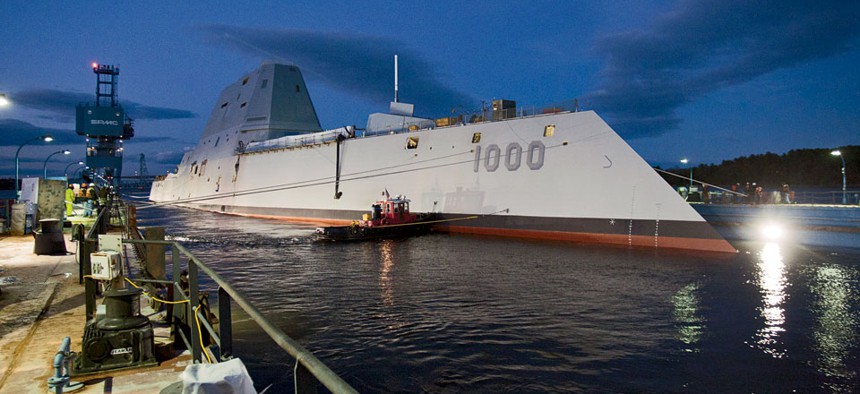
The Navy's USS Zumwalt, which launched in October 2013, will not be fully operational until 2016. Raytheon
Stealthy Advance
The incredibly automated, totally electrical Zumwalt is the world’s most sophisticated naval destroyer ever built.
It doesn’t look like a ship. It doesn’t even feel like a ship.
The hallways are too wide. The ceilings are incredibly high. There’s barely an outdoor deck. No bridge tower. No lookout crow’s nests. Flat-screen TV mounts are everywhere. In fact, the only sign that this is a ship are the steep deck ladders and “knee-knocker” air lock doorways sailors and ironworkers duck through from bow to stern. There’s also the relatively cavernous mission control room, which looks more like something from Houston than Groton, with large flat-screen displays at the front of the room, five rows of 18 workstations with even more flat screens, and a rear loft for flag officers to oversee the entire operation.
Welcome aboard the USS Zumwalt, the Navy’s first DDG-1000 stealth destroyer.
Launched in October 2013, she is an impossibly spaceship-looking trapezoid tower jutting from the still water. The incredibly automated, totally electrical vessel will hold a smaller crew than any destroyer before her. She can house two helicopters that can land in higher seas than ever and then be automatically pulled inside a concealed hangar. There’s room for several drone aircraft. It can power a small city. And her two advanced guns on the forward deck can hit a basketball with a 155mm Howitzer-sized artillery shell from miles away.
Eventually. For now, much of her interior has been bolted down, entire consoles and window panes are covered in plywood as the work continues to piece together the world’s most advanced naval destroyer ever built.
The menacing gray wedge of destruction that is sleeping eerily and dormant in a tranquil sliver of coastal Maine water is not scheduled for sea trials until 2015, and won’t be fully operational until at least 2016—in the Pacific, of course, where the Pentagon has sent the bulk of the fleet’s most advanced naval power. There, if ever needed, the Navy says the Zumwalt will be able to launch 600 shells from 63 miles away to an accuracy of within 30 inches.
Lest there be no doubt, she is a destroyer.
Defense Secretary Chuck Hagel visited the ship and the team of sailors and contractors working on her at Maine’s Bath Iron Works in November. Shipyard workers took Hagel’s staff and reporters through the vessel’s insides, where no photography was permitted (Hagel’s official photographer’s shots had to be cleared for security leaks.) But here’s what it’s like inside.
There is industrial construction equipment everywhere, making it difficult to judge the size of open space. But even with the clutter of welding tanks, electrical lines and scaffolding, it’s clear this is a ship built with room to move inside—especially on the hangar deck. Right up the middle is a track, where helicopters—two Seahawks, for example— can land and then attach to a hook that pulls the aircraft inside. No need for sailors there. In fact, everywhere from firefighting to lookouts, sailors are being replaced by technology.
Walking alongside the outer passageway on the hangar deck feels like walking along the inside wall of a giant tent, and is wide enough for a small fork truck to drive through. The ship has an external skin that shoots from the hull right up past what would be the top deck. So, instead of chrome railings and a seaside view, a wall of gray protects the sailors inside.
At the mission control room, complete with new paint smell, one can still see the giant rivets where the 900-ton composite deck house—that top trapezoid thing—was bolted to the steel hull.
“That happened in December [2012],” said Todd Estes, DDG-1000 program office manager, who proudly showed off the build. “It was very cold—a very cold night.”
About the only design element of the ship that resembles a battleship are her forward guns. But these are not your grandfather’s guns. In tests they have proved incredibly accurate, ship workers boasted. “If we missed by 30 to 40 inches, that was a bad shot,” said one industry official overseeing the ship, who asked to remain anonymous.
Hagel praised the workforce that gathered dockside in the chilly Maine wind and said the ship reflected the diversity of future threats the United States will face as it heads to the Pacific. “Assigning this new ship to that rebalance is an important signal of the commitment that we are making to a part of the world.”
He didn’t say specifically which adversaries she will face when she finally reaches the Pacific. But silently the Zumwalt held firm behind Hagel, the chop picked up across the water, and as the secretary left, the shipyard workers scurried back to the ship and the work still to be done.
NEXT STORY: Which Comes First, Resources or Results?







